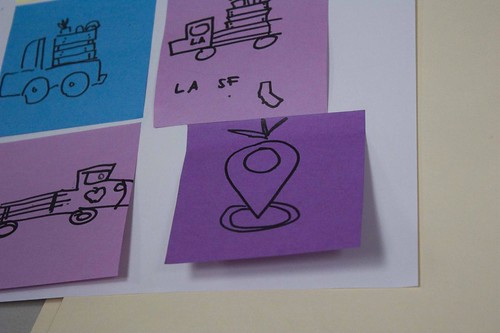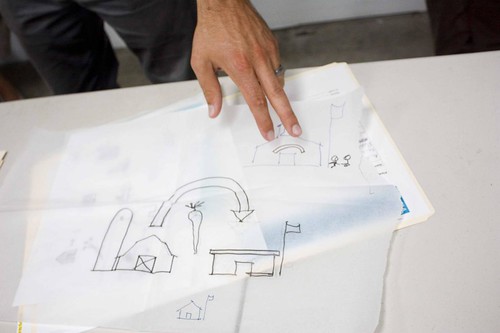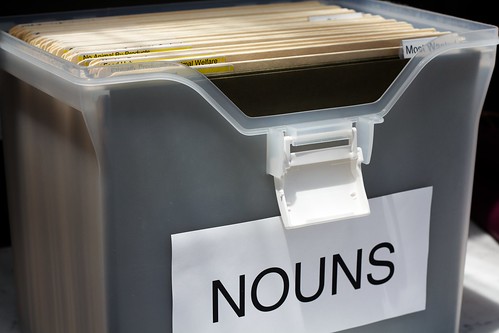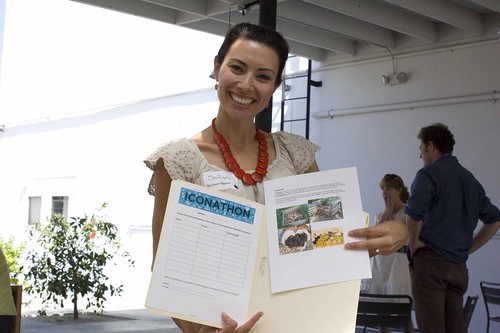We had another great Iconathon in Los Angeles on Saturday August 13, 2011.
In Iconathons, designers, public policy people, coders and other interested citizens get together to develop new civic symbols for the public domain. These symbols can be used in new web applications, infographics, signage, policy documents, maps and anywhere else that we need symbols. These symbols also are critical in reaching across communication barriers such as language & cognition.
In this Iconathon initiative, we are developing new symbols for a number of themes. The theme of the Los Angeles Iconathon was Food & Nutrition.
The day started with Amanda Shaffer (Urban & Environmental Policy Institute at Occidental College) giving a great presentation about food issues in Los Angeles, and suggestions on how new symbols could help provide more access to healthy foods.
Los Angeles has some of worst food deserts in the country. Obesity is a serious problem, as is access to supermarkets, with East LA having the least number of supermarkets per person. Food is mostly found in convenience stores, and these stores do not often have fresh produce. I learned from one of the event attendees, Rosanita Ratcliff, that some children in South LA have never seen squash, cucumbers or strawberries.
We also learned that the WIC (women, infants and children) program has historically not provided fresh produce to these mother in need, but there are new initiatives to get fresh local produce into these stores. Amanda Schaffer said that a helpful new symbol would be one that indicates “locally grown,” an easy to recognize symbol that could be used in connection with food education initiatives. Similarly, if we had recognizable symbols for Farmer’s Markets, Community Gardens, and different types of food stores, we could coordinate & map some of the various efforts of different food policy & food justice initiatives. (Or additionally, in conjunction with projects like the Code for America Farmer’s Market API or with the Open Food Data Standard project)
At one point during the event, Max Kanter of Food Forward excitedly proclaimed (something to this effect), “These symbols could actually be used and be out there in the world helping people find & access healthy food.” Designer Christine Geronaga said that this event combined the two things she was most passionate about: food & good design, and also that events like these keep her design wits sharp.
We were all very excited & emotional in having an the opportunity to give back and hope to help improve communications about healthy food initiatives in Los Angeles and other cities. At one point in the day, I looked around in complete awe that everyone had come together for such a good cause.
What happens next?
A group of about 6 volunteer illustrators are developing the sketches that were ‘ready’ into vector images. They will work with Edward Boatman to get these symbols polished.
One of the challenges is to make symbols that work together as a set. We are seriously considering the idea that all of the symbols made through this Iconathon City Tour will be part of the very first “Municipal Symbol Suite” that we will be released into the public domain at some point later this fall through the Noun Project’s website. This symbol suite will contain all of the symbols that everyone worked on at all of the Iconathons. ![]()
Photos!
Iconathon Flickr Group (377 photos & counting)

(Photo Carren Jao)
What does this symbol look like to you?


(Photos Carren Jao)
Locally grown

(Photo Carren Jao)
Farm to School

(Photo Chach Sikes)
Rooftop Garden

(Photo Chach Sikes)
Fair Trade
Note: We have images & videos of all of these symbols & will be organized & publicly available soon.
Symbols that are “Ready” to vectorize
- Beehive/Bee (image | video)
- Farm (image | video)
- Farm to School (image | video)
- Food Bank/Pantry (image | video)
- School/Community Garden (image | video)
- Urban Farm (image | video)
- Fair Trade (image | video)
- Guerilla Gardening (image | video)
- Rooftop Garden (image | video)
Symbols that need a little more work
- Community Supported Agriculture (image | video)
- Farmer’s Market (image | video)
- Gluten-Free (image | video)
- Urban Agriculture (image | video)
- Free-Range (Cattle) (image | video)
- Free-Range (Chickens) (image | video)
- Fried (image | video)
- Fruit Picking/Fruit Tree/Orchard (image | video)
- Gleaning (image | video)
- Produce (image | video)
- Compost (image | video)
- Locally Grown (image | video)
- Taste Test (image | video)
Upcoming Iconathons
On August 6 in San Francisco our theme was 311, or non-emergency city services.
These are the upcoming Iconathons. If you live in these cities, please considering coming to the event. They are a great deal of fun.Find out more.
- August 20, Chicago, Democracy
- August 27, Seattle, Neighborhoods* (highly likely)
- September 3, Boston, Education
- September 10, Transportation, New York City

Box of Nouns (Photo Matt Smith)






These are great ideas. Additionally, I wish something would be possible about a simple thing as street signs. Nothing more aggravating (assuming one isn’t using a GPS) than learning about a stree name just as you come upon it instead of being able to see it about a half a block in advance. Would improve safety as well.
Wow – What a great event! These efforts will go far in improving the customer experience. And I agree with Barry – street signs are often misunderstood. It would be great to have an effort like this around that issue.
Love it. Like the “locally grown” icon idea. Similarly, perhaps an “organic” symbol is worth doing as well. So can people submit designs remotely, or do you have to actually be present at an inconothon? You guys planning on heading out east at all?
Very, very cool. Jives well with a lot of our efforts at USDA on this front!
Awesome and interesting!
LOVE!
It seems to me that its just as easy to learn that sun means sun as to learn that * means sun. It’s more transferable too. Additionally in any country proficiency in the primary language of commerce is is required for well paying jobs. The majority of people who can’t read sun are aren’t purchasing locally grown organics because they can’t find them, they are purchasing the cheapest “food” possible. Food deserts exist because the poor can’t afford to demand expensive fresh food. Icons aren’t going to change that. Am I missing something?